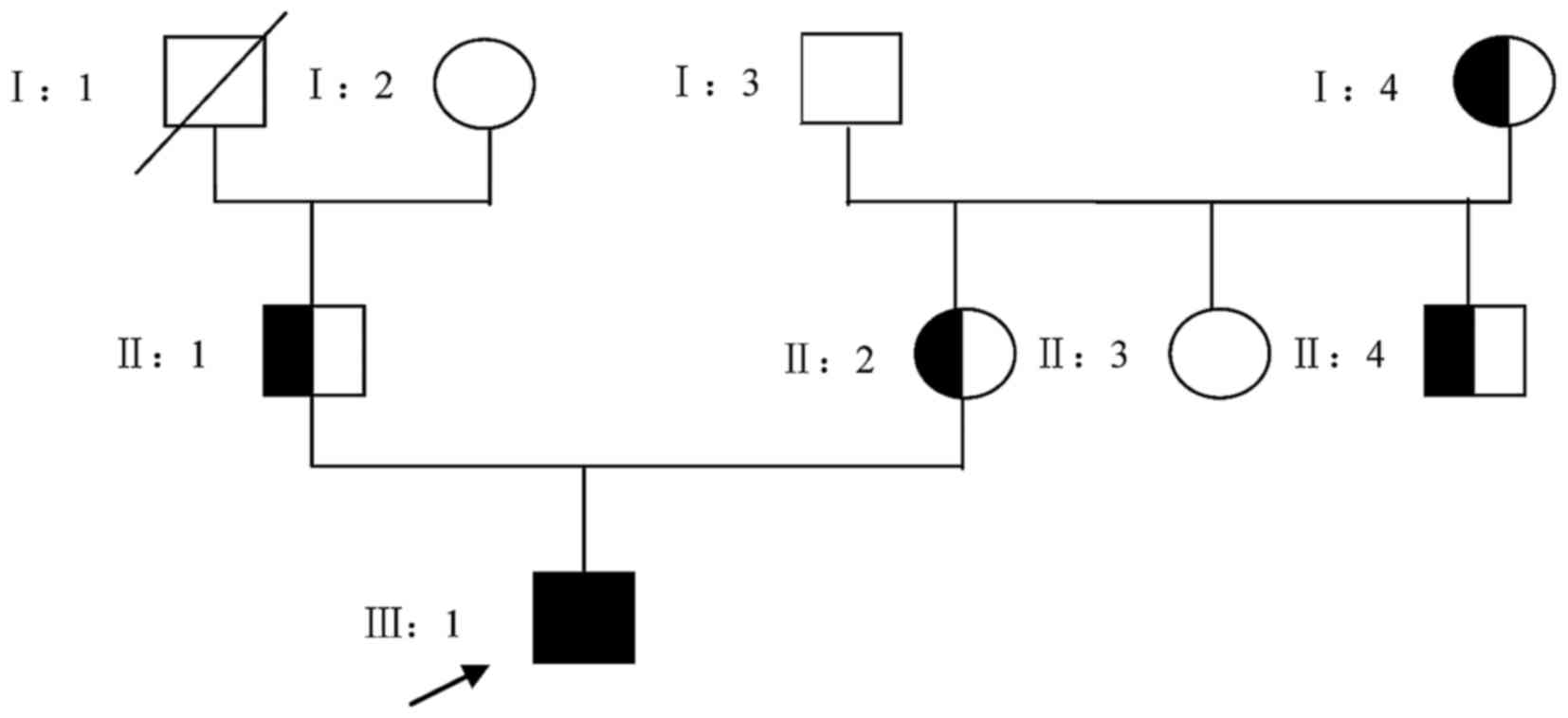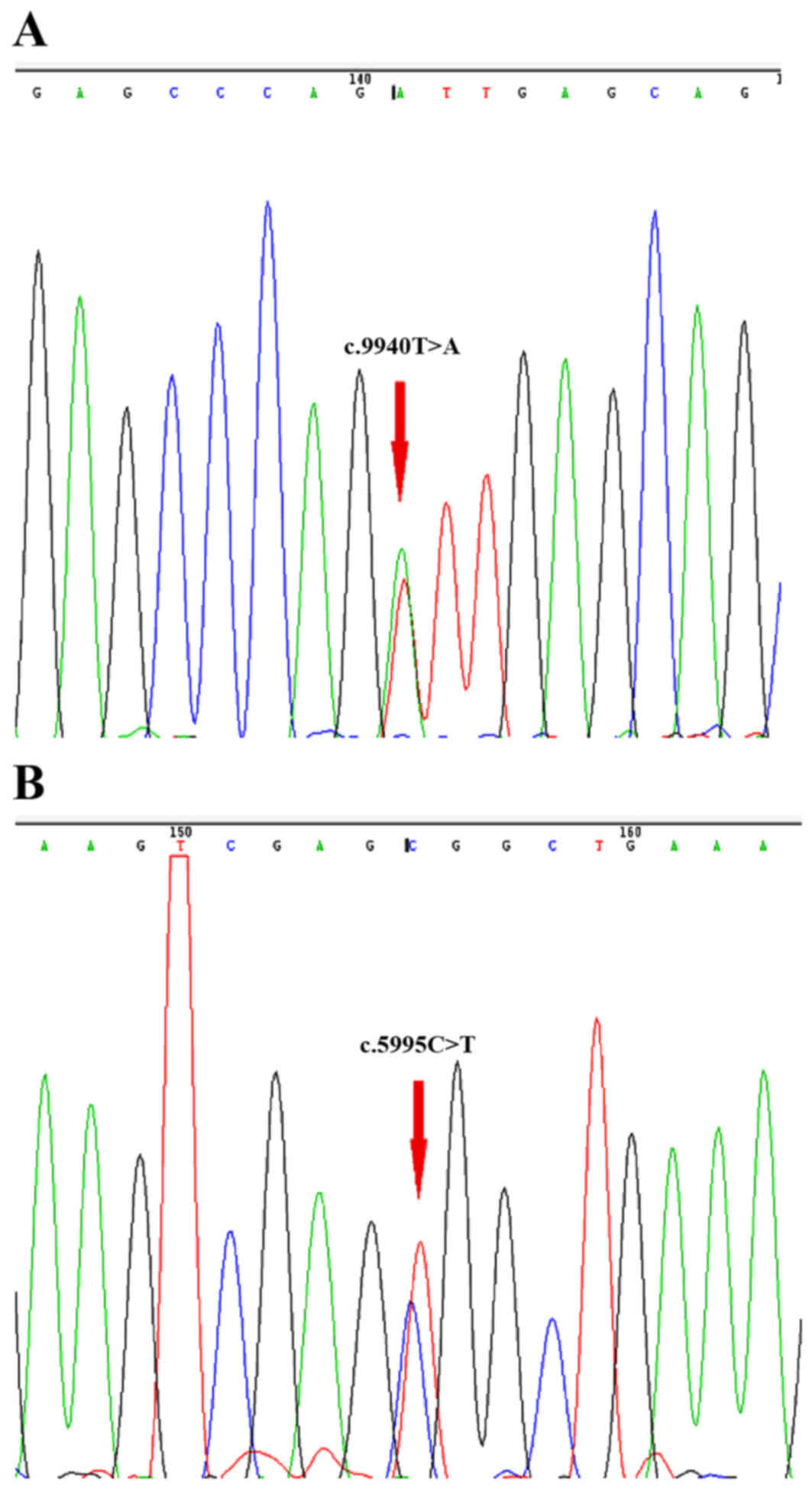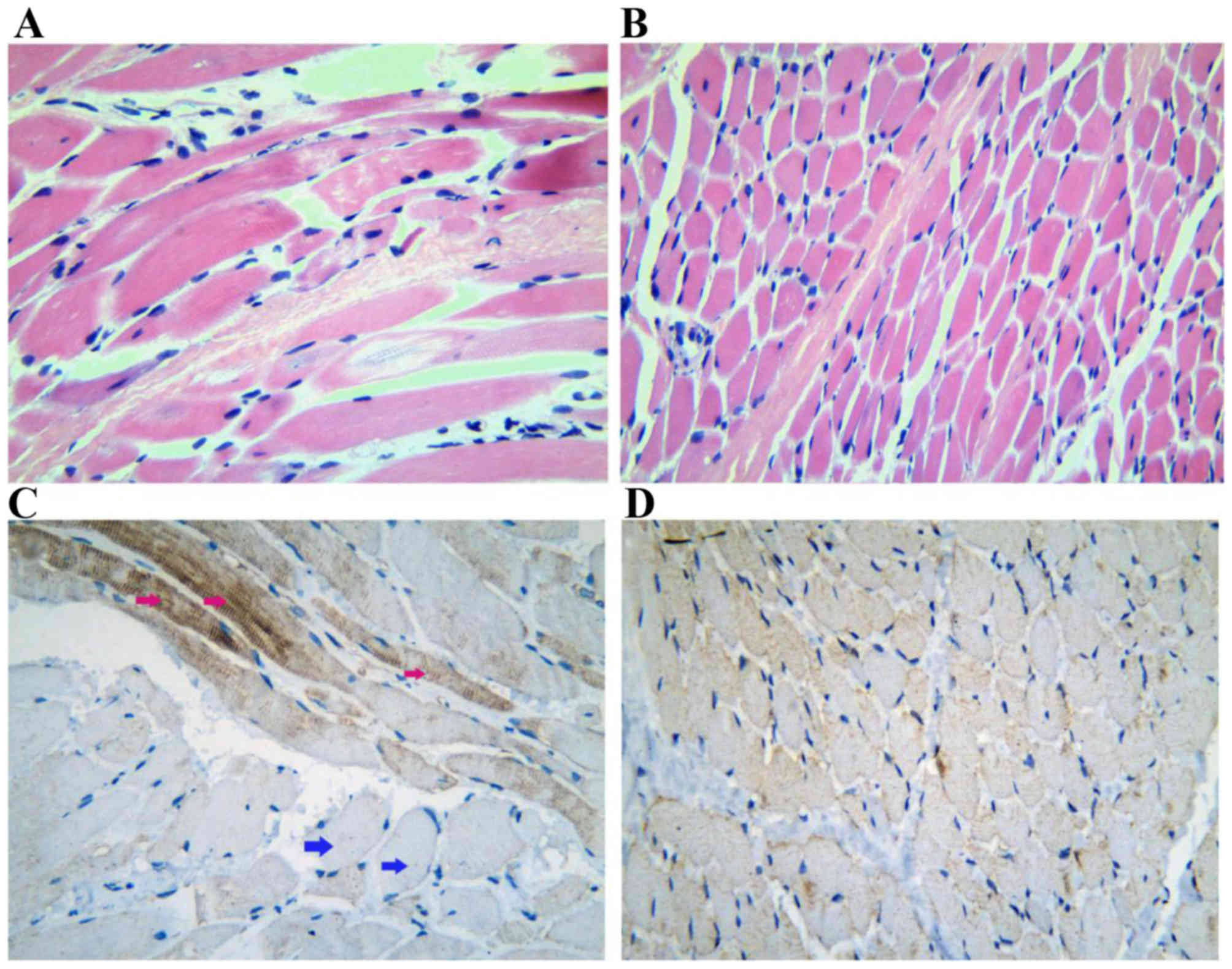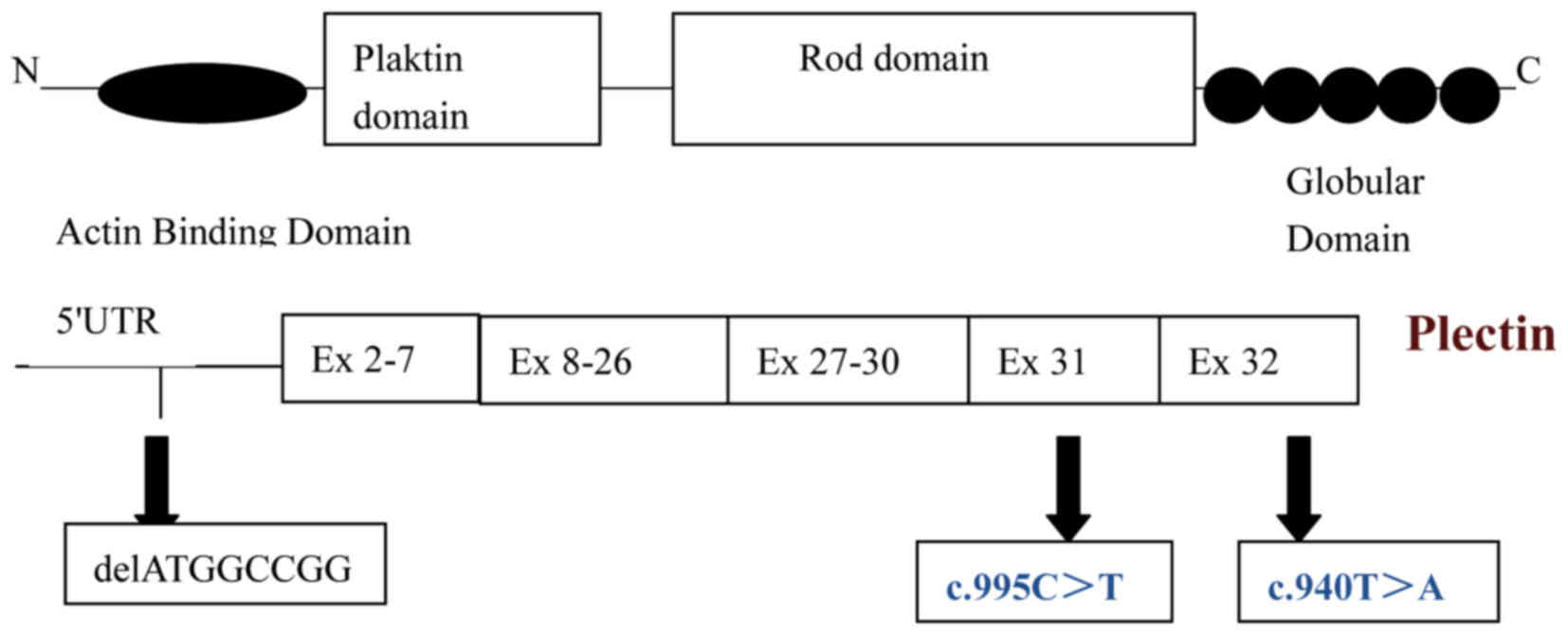Novel compound heterozygous PLEC mutations lead to early‑onset limb‑girdle muscular dystrophy 2Q
- Authors:
- Published online on: March 9, 2017 https://doi.org/10.3892/mmr.2017.6309
- Pages: 2760-2764
Abstract
Introduction
Limb-girdle muscular dystrophy [LGMD (MIM 253600 and MIM 159000)] refers to a long list of Mendelian disorders characterized by a progressive deterioration of proximal limb muscles (1). Men and women are equally affected, and the age of onset is usually between 5 and 30 years. The clinical course and expressivity can be variable, ranging from severe forms with rapid onset and progression to mild forms, in which the affected individual has relatively normal life span and levels of activity (2). The comprehensive analysis of clinical, electrophysiological and physiological findings, imaging, and biochemical data, may contribute to the clinical diagnosis of LGMD. However, genetic techniques are the most efficient tools for the identification of diagnosis and classification of LGMD. LGMD is divided into autosomal dominant LGMD1 and autosomal recessive LGMD2 based on the inheritance mode, and the appended letter refers to the order of identification for different chromosomal loci, followed by the inheritance mode (3). LGMD2Q is mutation specific to the plectin (PLEC1) gene at chromosome 8q24.3. The most common plectin-associated disorder is epidermolysis bullosa simplex (EBS-MD), a rare autosomal-recessive skin blistering disorder with late onset muscular dystrophy. In addition to EBS-MD, Plectin mutations cause EBS-MD with a myasthenic syndrome (EBS-MDMyS), EBS with pyloric atresia (EBS-PA; OMIM 612138) and EBS-Ogna (OMIM #131950), which affect the skin exclusively (4). The PLEC mutation has been identified in four patients from a consanguineous Turkish family as a homozygous deletion (c.1_9del) in exon 1f of the gene, which was the first report of plectin-associated LGMD2Q without skin involvement or myasthenic syndrome (5).
In the present study, targeted sequencing using a muscle disease gene panel was performed in a family with muscular dystrophy. The novel compound heterozygous mutations, c.5995C>T (p.Arg1999Trp) and c.9940T>A (p.Phe3314 Ile), in the PLEC gene were identified as the genetic cause of LGMD2Q in this family. Furthermore, defects in the plectin protein within the gastrocnemius were determined using immunocytochemistry. To the best of our knowledge, this is the second report of plectin-associated LGMD2Q without other symptoms, however, a novel genotype was found.
Patients and methods
Patients
The patient examined in the present study was from a three-generation, non-consanguineous Chinese family (Fig. 1). All the available individuals were subjected to a thorough neurological examination. Individuals were considered to be affected if they demonstrated progressive proximal pelvic and/or shoulder girdle muscle weakness. Other information, including the age at onset, symptoms at onset, creatine kinase (CK) level, electromyography, muscle atrophy and ultrasonic cardiogram, were obtained. A total of 200 unrelated ethnically matched normal controls (male/female:100/100) without diagnostic features of muscular dystrophy were recruited from mainland China. Venous blood samples were obtained from all alive members of the family. Genomic DNA was extracted according to a standard phenol-chloroform extraction method. As Duchenne muscular dystrophy is the most common form of inherited muscular dystrophy (6), the dystrophin gene was screened by multiplex ligation-dependent probe amplification (MLPA). If no mutation was identified by MLPA, subsequent targeted sequencing using a muscle disease gene panel was performed. Sanger sequencing was used to confirm the mutation in the proband and the other family members.
Exome capture
To systematically identify the disease-causing gene, targeted sequencing using a muscle disease gene panel, containing 169 known MD genes, was performed in an affected individual from the family. The muscle disease panel was a complete kit designed by Zhongguancun Huakang Gene Institute (Beijing, China) and synthetized using the Agilent SureSelect Target Enrichment technique. Next-generation sequencing was performed on an IlluminaNextSeq500 platform (Illumina, San Diego, CA, USA). A 4 µg sample of genomic DNA from the proband was used to construct the exome library. The genomic DNA was sheared into 150–250 bp by sonication and hybridized for enrichment, according to the manufacturer's protocol. The library enriched for the target region was sequenced on the Illumina NextSeq500 platform to obtain single-end reads with a read length of 75 bp.
Read mapping and variant analysis
The human reference genome was obtained from the University of California Santa Cruz database (build 37.1; version hg19; http://genome.ucsc.edu/), and sequence alignment was performed using the Burrows-Wheeler Alignment tool (version 0.7.10; http://bio-bwa.sourceforge.net/). High-quality alignment was required to guarantee variant calling accuracy (>0). Picard (version 1.119; http://sourceforge.net/projects/picard/) was used to mark duplicates resulting from polymerase chain reaction amplification. The Genome Analysis Tool kit (GATK; version 3.2–2; https://software.broadinstitute.org/gatk/) IndelRealigner and GATK RealignerTargetCreator were used to perform realignment around the Indels. GATK BaseRecalibrator was used to perform base quality score recalibration. GATK Variant Filtration was performed to render the raw callsets suitable for meaningful analysis. SAMtools (version 1.0; http://www.htslib.org/) was used to perform variant calling and identify single nucleotide polymorphisms (SNPs) or Indels. Following obtaining of the analysis-ready BAM alignment result, the ANNOVAR tool (version 2014-11-12; http://annovar.openbioinformatics.org) was performed to annotate SNPs and Indels. All candidate mutations were filtered against the SNP database (dbSNP138; http://www.ncbi.nlm.nih.gov/projects/SNP/snp_summary.cgi), International Hapmap Project (http://hapmap.ncbi.nlm.nih.gov/) and 1000 Genomes Project (2012 April release; http://www.1000genomes.org/) to remove the polymorphism loci. Polymorphism Phenotyping version 2 (PolyPhen-2), sorting intolerant from tolerant (SIFT) and MutationTaster (7) were used to predict whether an amino acid substitution affected the function of the protein. Sanger sequencing was used to validate the identified potential disease-causing variant in the family members.
Muscle pathology
Biopsy of the right gastrocnemius was performed in the patient. The morphology was observed under a microscope via hematoxylin and eosin staining. Immunohistochemistry was used to evaluate the plectin protein expression. Sections were incubated with the anti-rabbit monoclonal antibody targeting plectin (cat. no. ab32528; 1:100; Abcam, Cambridge, UK), and subsequently incubated with the Supervision™ Universal (Anti-Mouse/Rabbit) Detection Reagent (horseradish peroxidase conjugated; cat. no. D-3004; Lab Vision Corporation; Thermo Fisher Scientific, Inc., Waltham, MA, USA). The operation was performed according to the manufacturer's protocol.
Results
Patients
The proband in the present study was a 7-year-old boy with delayed independent walking at 2 years of age. Thereafter, he developed additional signs of weakness, with occasional falls and difficulties in climbing stairs. At his final follow-up, at 7 years of age, he demonstrated a Gowers sign, with proximal muscle strength of 4/5 on the Medical Research Council scale (8). There were no fluctuations of symptoms throughout the day. Muscle hypertrophy was observed. Serum CK at the age of 7 years was 2,408 U/l (normal<174 U/l), CK-MB was 350 U/l (normal<25 U/l), alanine aminotransferase30 U/l (normal<60 U/l), aspartate aminotransferase was75 U/l (normal<60 U/l). Echocardiogram showed normal anatomy and heart function. Pulmonary function tests showed no restriction. There were no ocular or bulbar signs. Neuropsychological assessment was normal. No mutation was identified by MLPA of DMD gene, and subsequent targeted sequencing using a muscle disease gene panel was performed.
Genetics
In the present study, a total of 2,840,000 reads of 75-bp single-end read sequence were obtained from the patient, with 2,830,000 reads (99.93%) aligned to the human reference sequence and 193 Mb mapped to the targeted region. A sequence depth of ~112.24X provided sufficient data to obtain 99.9% coverage of the target exome region. A total of 112 genetic variants were identified in the coding regions or the splice sites. Known variants, which were identified in dbSNP138, International Hapmap Project and 1,000 Genome Project, were excluded. Synonymous mutations were also excluded. PolyPhen-2, SIFT and MutationTaster were used to predicted the possible effect of amino acid substitutions and the functions of proteins. Applying the above strategy, >96% candidate genes were reduced. Among the 169 selected genes, no candidate homozygous mutation was identified. Novel compound heterozygous mutations, c.5995C>T (p.Arg1999Trp) and c.9940T>A (p.Phe3314 Ile) in the PLEC gene, and c.24646A>G (p.Ile8216Val) and c.18530T>G (p.Leu6177Arg) in the TTN gene, were identified (Table I; Fig. 3A and B). All mutations were missense mutations, which can affect protein function. The proband's father was identified with the same mutations in the TTN gene, but without the LGMD phenotype. Therefore, it was possible to exclude the heterozygous c.24646A>G (p.Ile8216Val) and c.18530T>G (p.Leu6177Arg) mutations as potential causes of the LGMD phenotype in the family. The compound heterozygous variants in the PLEC gene were co-segregated within the family. Heterozygous variants were identified in other unaffected family members. PolyPhen-2 and SIFT predicted that the mutations were possibly damaging and damaging respectively. MutationTaster predicted that the alteration was disease causing, with a probability value of 0.935 and 1. Additionally, these variants were absent in the 200 normal controls from exome sequencing of the Ensembl database.
Muscle pathology
Muscle biopsy showed that significant dystrophic features were present in muscular fibers, which had structure distortion. The muscular fibers were also unequal in size, and scattered necrotic fibers were found (Fig. 2A and B). To determine the immunolocalization and alteration of plectin (Fig. 2C and D) in the skeletal muscle of the patient, immunohistochemical staining of the muscle tissue was performed. Plectin showed marked sarcoplasmic staining in certain fibers, however, staining was irregular and faint in other fibers, and loss of sarcolemmal staining was observed (Fig. 2C and D).
Discussion
PLEC is a multifunctional cytolinker (>500 kDa), which is expressed in a wide variety of cell and tissues, including skin and muscle (9,10). The PLEC gene comprises a complex organization of 32 exons located on chromosome 8q24. It has eight variable first exons (A-H), which are each spliced to a common set of downstream constant second exons to generate diverse functional mRNAs (11,12). In 1996, EBS-MD (OMIM #226670) was reported as being caused by mutations in the PLEC gene (13,14). An increasing number of diseases, including LGMD2Q, EBS-MD-MyS, EBS-PA and EBS-Ogna, have subsequently been identified by mutations within this gene. The majority of PLEC mutations have been associated with EBS and progressive muscular dystrophy. Few studies have reported mutations in PLEC as being associated with muscular dystrophy without a skin disorder.
In the present study, targeted sequencing using a muscle disease gene panel was performed in the affected individual of the family examined. Following the exclusion of SNPs and synonymous mutations, PolyPhen-2, SIFT and MutationTaster were used to predict the function of mutations. The novel compound heterozygous mutations, c.5995C>T (p.Arg1999Trp) and c.9940T>A (p.Phe3314 Ile), were identified in the PLEC gene in the Chinese family with LGMD2Q. To acquire a more accurate diagnosis and an improved understanding of the clinical spectrum, immunocytochemistry was used to visualize and localize specific proteins within the gastrocnemius. A defect in the plectin protein was found in myofibers. The proband exhibited the first signs of muscle weakness at 2 years old. Neither epidermolysis bullosa nor any other dermatologic disorder or symptoms, for example myasthenic syndrome, were found until the proband's final follow-up. Gundesli et al (5) reported on a consanguineous Turkish family containing four individuals suffering from muscle weakness. They showed early-onset LGMD symptoms with progressivity, but no myasthenic features, oculo-bulbar weakness or no skin disorders. The individuals were diagnosed with LGMD2Q due to a homozygous 9 bp deletion in plectin isoform 1f using GeneChip Mapping 250K NspI SNP arrays from Affymetrix (5). The tissue-specific expression of the plectin isoform 1f was suggested as an explanation for the observation of an MD phenotype without skin abnormality. In the present study, the proband exhibited the same LGMD2Q phenotype as the previous study, however, the genotype differed from that of the prior study. The c.5995C>T (p.Arg1999Trp) and c.9940T>A (p.Phe3314 Ile) compound heterozygous mutations in the PLEC gene were located within C-terminal globular domains and were identified in all PLEC isoforms. Exon31, 32 encodes the central Rod domain where dimerization occurs (Fig. 4). Previously, it was shown that Exon 31, 32 predominantly harbors mutations in patients with EBS-MD (4). Rouan et al (15) reported on a patient with EBS-MD with compound heterozygous mutations (6013G>T and 13378A>T) in Exon31, 32. These mutations are nonsense mutations, which result in downstream premature termination of codons and a non-functional truncated peptide chain. However, the heterozygous mutations in the present study were missense mutations. These can alter amino acid sequences and lead to an abnormal peptide chain, which affects protein features and function. This may explain the lack of dermatologic disorders in the proband, despite mutations being in the same exon.
Until now, no clear genotype/phenotype correlation has been identified from the positions of mutations in the PLEC gene. The phenotype is variable due to the different genotype in the PLEC gene. The present study described a pure LGMD2Q, which was caused by novel compound heterozygous mutations in Exon31, 32 of the PLEC gene. These findings improve current knowledge of the mutation spectrum of the PLEC gene associated with LGMD2Q. Compound heterozygous mutations in the central Rod domain caused LGMD2Q with the absence of prominent skin involvement. Additional cases are required for confirmation of these observations, and further investigations are required to understand the pathologic mechanism of dystrophies by detecting downstream and upstream signaling pathways.
Acknowledgements
This study was supported by the Hospital Starting Fund for Study Abroad Returnees (grant no. 20100001) and the Fund of Prevention and Treatment of Critical Illness for Children.
References
|
Narayanaswami P, Weiss M, Selcen D, David W, Raynor E, Carter G, Wicklund M, Barohn RJ, Ensrud E, Griggs RC, et al: Evidence-based guideline summary: Diagnosis and treatment of limb-girdle and distal dystrophies: Report of the guideline development subcommittee of the American Academy of Neurology and the practice issues review panel of the American Association of Neuromuscular & Electrodiagnostic Medicine. Neurology. 83:1453–1463. 2014. View Article : Google Scholar : PubMed/NCBI | |
|
Nigro V, Aurino S and Piluso G: Limb girdle muscular dystrophies: Update on genetic diagnosis and therapeutic approaches. Curr Opin Neurol. 24:429–436. 2011. View Article : Google Scholar : PubMed/NCBI | |
|
Bushby KM: Diagnostic criteria for the limb-girdle muscular dystrophies: Report of the ENMC consortium on limb-girdle dystrophies. Neuromuscul Disord. 5:71–74. 1995. View Article : Google Scholar : PubMed/NCBI | |
|
Winter L and Wiche G: The many faces of plectin and plectinopathies: Pathology and mechanisms. Acta Neuropathol. 125:77–93. 2013. View Article : Google Scholar : PubMed/NCBI | |
|
Gundesli H, Talim B, Korkusuz P, Balci-Hayta B, Cirak S, Akarsu NA, Topaloglu H and Dincer P: Mutation in exon 1f of PLEC, leading to disruption of plectin isoform 1f, causes autosomal-recessive limb-girdle muscular dystrophy. Am J Hum Genet. 87:834–841. 2010. View Article : Google Scholar : PubMed/NCBI | |
|
Emery AE: Population frequencies of inherited neuromuscular diseases-a world survey. Neuromuscul Disord. 1:19–29. 1991. View Article : Google Scholar : PubMed/NCBI | |
|
Schwarz JM, Cooper DN, Schuelke M and Seelow D: MutationTaster2: Mutation prediction for the deep-sequencing age. Nat Methods. 11:361–362. 2014. View Article : Google Scholar : PubMed/NCBI | |
|
Scott OM, Hyde SA, Goddard C and Dubowitz V: Quantitation of muscle function in children: A prospective study in Duchenne muscular dystrophy. Muscle Nerve. 5:291–301. 1982. View Article : Google Scholar : PubMed/NCBI | |
|
Wiche G: Plectin: General overview and appraisal of its potential role as a subunit protein of the cytomatrix. Crit Rev Biochem Mol Biol. 24:41–67. 1989. View Article : Google Scholar : PubMed/NCBI | |
|
Wiche G, Krepler R, Artlieb U, Pytela R and Denk H: Occurrence and immunolocalization of plectin in tissues. J Cell Biol. 97:887–901. 1983. View Article : Google Scholar : PubMed/NCBI | |
|
Zhang T, Haws P and Wu Q: Multiple variable first exons: A mechanism for cell- and tissue-specific gene regulation. Genome Res. 14:79–89. 2004. View Article : Google Scholar : PubMed/NCBI | |
|
Fuchs P, Zörer M, Rezniczek GA, Spazierer D, Oehler S, Castañón MJ, Hauptmann R and Wiche G: Unusual 5′ transcript complexity of plectin isoforms: Novel tissue-specific exons modulate actin binding activity. Hum Mol Genet. 8:2461–2472. 1999. View Article : Google Scholar : PubMed/NCBI | |
|
Gache Y, Chavanas S, Lacour JP, Wiche G, Owaribe K, Meneguzzi G and Ortonne JP: Defective expression of plectin/HD1 in epidermolysis bullosa simplex with muscular dystrophy. J Clin Invest. 97:2289–2298. 1996. View Article : Google Scholar : PubMed/NCBI | |
|
McLean WH, Pulkkinen L, Smith FJ, Rugg EL, Lane EB, Bullrich F, Burgeson RE, Amano S, Hudson DL, Owaribe K, et al: Loss of plectin causes epidermolysis bullosa with muscular dystrophy: cDNA cloning and genomic organization. Genes Dev. 10:1724–1735. 1996. View Article : Google Scholar : PubMed/NCBI | |
|
Rouan F, Pulkkinen L, Meneguzzi G, et al: Epidermolysis bullosa: novel and de novo premature termination codon and deletion mutations in the plectin gene predict late-onset muscular dystrophy. J Invest Dermatol. 114:381–387. 2000. View Article : Google Scholar : PubMed/NCBI |













